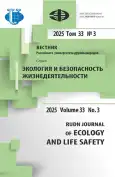Assessment of the possibility of using hydrolysis lignin for biological reclamation
- Autores: Yurk V.M.1, Shashkova A.A.1, Snegirev V.A.1, Tretyakova N.A.1
-
Afiliações:
- Ural Federal University
- Edição: Volume 33, Nº 3 (2025)
- Páginas: 298-311
- Seção: Industrial Ecology
- URL: https://journal-vniispk.ru/2313-2310/article/view/324014
- DOI: https://doi.org/10.22363/2313-2310-2025-33-3-298-311
- EDN: https://elibrary.ru/RDGODG
- ID: 324014
Citar
Resumo
Hydrolysis lignin is a large-scale industrial waste that has no useful application. It is disposed in special landfills, causing alienation of valuable lands and having a negative impact on the environment. The aim of the work was to evaluate the possibility of using hydrolysis lignin formed as a result of the activities of the Ivdelsky timber processing plant for biological reclamation of disturbed lands. The object of the study is hydrolysis lignin from a lignin storage facility located in the city of Ivdel, the Sverdlovsk region. The study of the composition of the runoff accumulated in the lignin deposit showed that the content of lignin in it is 58.97 wt. %, also a significant part is the mineral fraction, represented mainly by oxides of silicon, aluminum and calcium. The total content of heavy metals does not exceed 0.15 wt. %. The experiments have shown that the toxic effect of the aqueous extract on the test culture (red clover Trifolium pratense L.) is absent, respectively, the waste is not dangerous to the environment. The substrates used for biological reclamation should not have a toxic effect on the crops grown. In this regard, a phytotoxicity assessment was carried out by growing test object (oats Avena sativa L. and red clover Trifolium pratense L.) on a substrate from the waste. The results of the experiment showed a lower percentage of germination and growth of plant biomass compared to the control, but the test objects developed normally, there were no damages on the leaves and shoots. Thus, the studies have shown the possibility of using the hydrolysis lignin as a substrate for biological reclamation without preliminary treatment.
Palavras-chave
Sobre autores
Victoria Yurk
Ural Federal University
Autor responsável pela correspondência
Email: v.yurk@yandex.ru
ORCID ID: 0000-0002-5261-742X
Código SPIN: 2477-3934
Ph.D. of Chemical Sciences, Associate Professor, Department of Chemical Technology of Fuel and Industrial Ecology
19 Mira St, Ekaterinburg, 620062, Russian FederationAleksandra Shashkova
Ural Federal University
Email: aleksa_shashkova2207@mail.ru
Bachelor’s Student, Department of Chemical Technology of Fuel and Industrial Ecology 19 Mira St, Ekaterinburg, 620062, Russian Federation
Vyacheslav Snegirev
Ural Federal University
Email: v.a.snegirev@urfu.ru
ORCID ID: 0000-0002-6348-4271
Assistant Lecturer, Department of Chemical Technology of Fuel and Industrial Ecology
19 Mira St, Ekaterinburg, 620062, Russian FederationNatalia Tretyakova
Ural Federal University
Email: n-tretyakova@mail.ru
ORCID ID: 0000-0003-3319-270X
Código SPIN: 3385-5894
Ph.D. of Chemical Sciences, Associate Professor, Department of Chemical Technology of Fuel and Industrial Ecology
19 Mira St, Ekaterinburg, 620062, Russian FederationBibliografia
- Shorygina NN, Reznikov VM, Elkin VV. Reactivity of lignin. Moscow: Nauka; 1976 (In Russ.)
- Chudakov MI. Industrial use of lignin. Moscow: Goslesbumizdat; 1962, 183 p. (In Russ.)
- Nikishov VD. Integrated use of wood Textbook for universities. Moscow: Lesnaya promyshlennost; 1985 (In Russ.)
- Simkin YuYa, Lemeshevsky AI. Perspective directions of processing hydrolytic lignin from storage. Actual problems of aviation and cosmonautics. Proceedings of the V International Scientific and Practical Conference dedicated to the Day of Cosmonautics: in 3 volumes. Vol. 2. Loginov YuYu. (ed.). Krasnoyarsk: Reshetnev University; 2019. p. 503-505. (In Russ.) EDN: SYOQHT
- Valyuzhinich MA. Burning of hydrolyzed lignin and milling peat in a boiler plant with pre-heating of the fluidized bed. Heat supply News. 2011. No. 4. P. 33-38. (In Russ.)
- Wrzesniewska-Tosik K, Tomaszewski W, Struszczyk H. Manufacturing and thermal properties of lignin-based resins. Fibres and Text. East. Eur. 2001;9(2):50-53.
- Kapustina IB, Yakimtsov VP, Kazazyan VI. The use of hydrolyzed lignin for the production of composite materials. Chemistry for Sustainable Development. 2003;11(3):489-492. (In Russ.) EDN: OXPIFJ
- Markelov DA, Nitsak OV, Gerashchenko II. Comparative study of the adsorption activity of medicinal sorbents. Pharmaceutical Chemistry Journal. 2008;42(7):405-408. (In Russ.) EDN: TLROUX
- Belyaev EY. Production and application of wood activated carbons for environmental purposes. Chemistry of plant raw materials. 2000. No. 2. P. 5-15. (In Russ.)
- Mikhailov AV. Open-Pit Mining of Lignin Waste Storage. Zapiski Gornogo instituta. 2017;223:44-50. (In Russ.) https://doi.org/10.18454/PMI.2017.1.44 EDN: YGCWLJ
- Volchatova IV, Medvedeva SA. Efficiency of hydrolyzed lignin fertilizer for gray forest soil. Eurasian Soil Science. 2014;(11):30-33. (In Russ.) EDN: SYIVXF
- Bormatenkov AM, Grafova EO, Zaitseva MI, Syunev VS. Use of sewage sludge and wood processing waste mixtures as a soil substrate for reclamation of disturbed lands. Resources and Technology. 2020;17(2):97-113. (In Russ.) https://doi.org/10.15393/j2.art.2020.5342 EDN: OMMAUW
- Pashkevich MA, Petrova TA, Rudzisha E. Lignin sludge application for forest land reclamation: feasibility assessment. Journal of Mining Institute. 2019;235:106-112. (In Russ.) https://doi.org/10.31897/PMI.2019.1.106 EDN: BJFLBU
- Rastvorova OG., Andreev DP., Gagarina EI., Kasatkina GA., Fedorova NN. Chemical analysis of soils. St. Petersburg: St. Petersburg University Press; 1995 (In Russ.) EDN: TJQFRD
Arquivos suplementares









